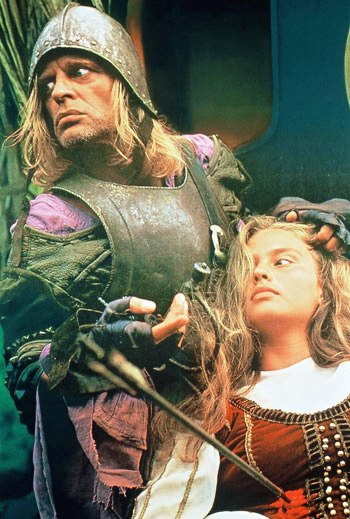
 Werner Herzog’s 1972 masterwork attacks the colonial mindset through the story of an insane Spanish conquistador searching for a lost city of gold in the Amazon rain forest.
Werner Herzog’s 1972 masterwork attacks the colonial mindset through the story of an insane Spanish conquistador searching for a lost city of gold in the Amazon rain forest.
An expedition of Spanish conquistadors, exploring the Amazon jungles in search of the golden city of El Dorado, is overthrown in a mutiny by the power-hungry Don Lope de Aguirre, who drives the soldiers ever deeper into the forest on an insane quest to establish a private kingdom. From 1972, directed by Werner Herzog, the film is Aguirre, the Wrath of God.
Aguirre was a real historical figure, but for Werner Herzog he becomes a metaphor. Herzog, one of the boldest experimenters in modern cinema, here subverts the adventure genre in the service of his metaphysical and political obsessions. For him, the Spanish Conquest, so blithely related in our history books, is a symbol of self-destruction. The subjugation of the Indians, the maintenance of the trappings of European royalty in the midst of the most threatening wilderness, Aguirre’s gradual equation of his own will with the wrath of the divine will—all these combine to create a mood of strangeness, terror, and helplessness in the face of evil. In contrast to the more conventional idea of civilization freeing us from “the jungle,” Herzog’s savage parable portrays the quest of such civilization as cruelty and madness, and the jungle as an impersonal and immortal force that will swallow all who pretend to conquer it.
Filmed in Peru, the picture has astonishing photography by Thomas Mauch and a compelling performance by Klaus Kinski as Aguirre, whose hunched, brooding presence emanates a sense of delusional power over his surroundings. Herzog does not make it easy for the audience—his visual perspectives are unfailingly confrontational and disturbing, his point of view eerily detached, like an over-aware observer who is powerless to intervene in disaster. There are no special effects. The actors and crew actually went through the arduous and treacherous river journey. The shoot was so difficult that Kinski is said to have threatened to leave, only staying after a physical altercation with the director.
At one point, when the conquistadors encounter an Indian, a priest hands him a Bible, saying it’s the word of God, and the Indian then puts the book to his ear but can hear nothing. Then they notice he has a little gold ball hanging around his neck. They rip it away from him and ask, “Where is the city of gold?” Thus the pretense of faith gives way to the reality of greed. In a late scene, we behold a raft being covered in hundreds of scurrying monkeys. This bizarre masterpiece is full of such memorable scenes and set pieces.
Aguirre, the Wrath of God is one of Werner Herzog’s most brilliant achievements. In this film, he attacks the age-old quest to dominate and conquer the world, depicting it as sheer madness. The viewer is overwhelmed with a vision of the utter futility of the power principle in human affairs.

